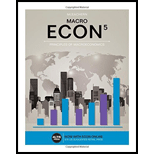Initially, Ginny earns a salary of $300 per year and Eric earns a salary of $200 per year. Ginny lends Eric $100 for one year at an annual interest rate of 16% with the expectation that the rate of inflation will be 12% during the one-year life of the loan. At the end of the year, Eric makes good on the loan by paying Ginny $116. Consider how the loan repayment affects Ginny and Eric under the following scenarios. Scenario 1: Suppose all prices and salaries rise by 12% (as expected) over the course of the year. In the following table, find Ginny's and Eric's new salaries after the 12% increase, and then calculate the $116 payment as a percentage of their new salaries. (Hint: Remember that Ginny's salary is her income from work and that it does not include the loan payment from Eric.) Value of Ginny's new salary after one year The $116 payment as a percentage of Ginny's new salary Value of Eric's new salary after one year The $116 payment as a percentage of Eric's new salary Scenario 2: Consider an unanticipated decrease in the rate of inflation. The rise in prices and salaries turns out to be 2% over the course of the year rather than 12%. In the following table, find Ginny's and Eric's new salaries after the 2% increase, and then calculate the $116 payment as a percentage of their new salaries. percentage of Ginny's new salary Value of Eric's new salary after one year The $116 payment as a percentage of Eric's new salary Value of Ginny's The $116 payment as a new salary after one year An unanticipated decrease in the rate of inflation benefits (Eric or Ginny) and harms (Eric or Ginny).
Initially, Ginny earns a salary of $300 per year and Eric earns a salary of $200 per year. Ginny lends Eric $100 for one year at an annual interest rate of 16% with the expectation that the rate of inflation will be 12% during the one-year life of the loan. At the end of the year, Eric makes good on the loan by paying Ginny $116. Consider how the loan repayment affects Ginny and Eric under the following scenarios. Scenario 1: Suppose all prices and salaries rise by 12% (as expected) over the course of the year. In the following table, find Ginny's and Eric's new salaries after the 12% increase, and then calculate the $116 payment as a percentage of their new salaries. (Hint: Remember that Ginny's salary is her income from work and that it does not include the loan payment from Eric.) Value of Ginny's new salary after one year The $116 payment as a percentage of Ginny's new salary Value of Eric's new salary after one year The $116 payment as a percentage of Eric's new salary Scenario 2: Consider an unanticipated decrease in the rate of inflation. The rise in prices and salaries turns out to be 2% over the course of the year rather than 12%. In the following table, find Ginny's and Eric's new salaries after the 2% increase, and then calculate the $116 payment as a percentage of their new salaries. percentage of Ginny's new salary Value of Eric's new salary after one year The $116 payment as a percentage of Eric's new salary Value of Ginny's The $116 payment as a new salary after one year An unanticipated decrease in the rate of inflation benefits (Eric or Ginny) and harms (Eric or Ginny).
Chapter7: Unemployment And Inflation
Section: Chapter Questions
Problem 7E
Related questions
Question
Don't use ai to answer I will report your answer Solve it Asap with explanation and calculation

Transcribed Image Text:Initially, Ginny earns a salary of $300 per year and Eric earns a salary of $200 per year. Ginny
lends Eric $100 for one year at an annual interest rate of 16% with the expectation that the
rate of inflation will be 12% during the one-year life of the loan. At the end of the year, Eric
makes good on the loan by paying Ginny $116. Consider how the loan repayment affects
Ginny and Eric under the following scenarios.
Scenario 1: Suppose all prices and salaries rise by 12% (as expected) over the course of the
year. In the following table, find Ginny's and Eric's new salaries after the 12% increase, and
then calculate the $116 payment as a percentage of their new salaries. (Hint: Remember that
Ginny's salary is her income from work and that it does not include the loan payment from
Eric.)
Value of Ginny's new
salary after one year
The $116 payment as a
percentage of Ginny's
new salary
Value of Eric's new
salary after one year
The $116 payment as a
percentage of Eric's
new salary
Scenario 2: Consider an unanticipated decrease in the rate of inflation. The rise in prices and
salaries turns out to be 2% over the course of the year rather than 12%. In the following table,
find Ginny's and Eric's new salaries after the 2% increase, and then calculate the $116
payment as a percentage of their new salaries.
percentage of Ginny's
new salary
Value of Eric's new
salary after one year
The $116 payment as a
percentage of Eric's new
salary
Value of Ginny's The $116 payment as a
new salary after
one year
An unanticipated decrease in the rate of inflation benefits (Eric or Ginny) and harms (Eric or
Ginny).
Expert Solution
This question has been solved!
Explore an expertly crafted, step-by-step solution for a thorough understanding of key concepts.
Step by step
Solved in 2 steps

Recommended textbooks for you


Principles of Economics 2e
Economics
ISBN:
9781947172364
Author:
Steven A. Greenlaw; David Shapiro
Publisher:
OpenStax



Principles of Economics 2e
Economics
ISBN:
9781947172364
Author:
Steven A. Greenlaw; David Shapiro
Publisher:
OpenStax



